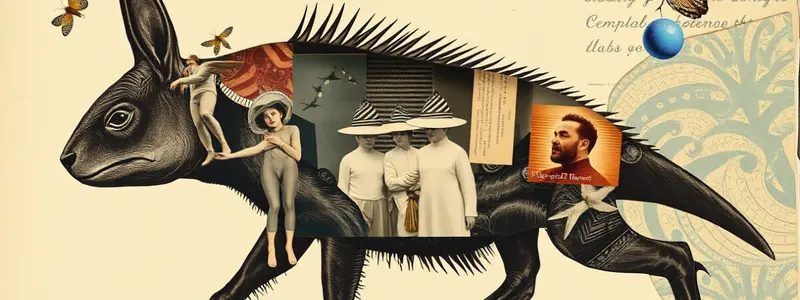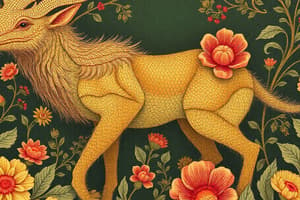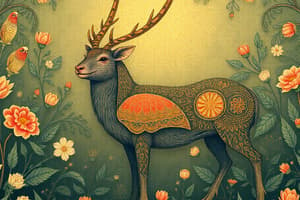Podcast
Questions and Answers
Which characteristic is NOT a common feature of animals?
Which characteristic is NOT a common feature of animals?
- Movement
- Internal digestion
- Ability to detect environmental stimuli
- Presence of a rigid cell wall (correct)
What is the primary way animals obtain their nutrients?
What is the primary way animals obtain their nutrients?
- By photosynthesis
- Through osmosis
- By absorbing nutrients from the soil
- By consuming other living organisms (correct)
What allows animal cells to take on different shapes?
What allows animal cells to take on different shapes?
- Increased water content
- Presence of a cell wall
- Presence of chloroplasts
- Absence of a cell wall (correct)
Which of the following statements about snails is true?
Which of the following statements about snails is true?
Which statement describes the function of a human nerve cell?
Which statement describes the function of a human nerve cell?
What characteristic is shared by virtually all animals?
What characteristic is shared by virtually all animals?
Which statement accurately describes the reproduction of most animals?
Which statement accurately describes the reproduction of most animals?
What role does movement play for animals?
What role does movement play for animals?
What feature distinguishes animals from plants?
What feature distinguishes animals from plants?
What is a typical life cycle feature of animals?
What is a typical life cycle feature of animals?
All animals reproduce asexually at some point in their life cycle.
All animals reproduce asexually at some point in their life cycle.
The nervous system is responsible for processing information and directing body responses in animals.
The nervous system is responsible for processing information and directing body responses in animals.
Internal digestion is a characteristic that is common to almost all animals.
Internal digestion is a characteristic that is common to almost all animals.
A snail is classified as an insect.
A snail is classified as an insect.
Animals primarily reproduce through binary fission and not through meiosis.
Animals primarily reproduce through binary fission and not through meiosis.
Animal cells lack a cell wall, allowing them flexibility.
Animal cells lack a cell wall, allowing them flexibility.
Muscles and nerves do not work together in animals to enable movement.
Muscles and nerves do not work together in animals to enable movement.
Most animals possess specialized cells, tissues, and organs.
Most animals possess specialized cells, tissues, and organs.
Heterotrophs can produce their own food.
Heterotrophs can produce their own food.
Animal sensory organs are responsible for detecting environmental stimuli.
Animal sensory organs are responsible for detecting environmental stimuli.
Flashcards are hidden until you start studying
Study Notes
Insects and Snails
- Insects are classified as animals, whereas snails belong to the mollusk family.
- Snails possess a large "foot" for movement and eyestalks for sensory functions.
Characteristics of Animals
- Animals are multicellular eukaryotes and cannot produce their own food.
- They are heterotrophs, obtaining nutrients by consuming other organisms.
Animal Cells
- Animal cells contain a nucleus and membrane-bound organelles but lack a cell wall.
- The absence of a cell wall provides flexibility, enabling a range of cell shapes and specialization for specific functions.
- Example: Human nerve cells are uniquely shaped to transmit impulses over long distances.
Animal Structure and Function
- Animals have specialized cells, tissues, organs, and organ systems (e.g., the nervous system) that facilitate complex functions.
- Common characteristics include sensory organs, the ability to move, and internal digestion.
- Animals can detect environmental stimuli (light, sound, touch) through sensory nerve cells, with responses managed by the nervous system.
Movement and Digestion
- All animals move at some point in their life cycle using muscles and nerves, which aids in foraging for food, finding mates, and escaping predators.
- Internal digestion is a universal trait, with animals consuming and processing other organisms via specialized tissues.
Animal Life Cycle and Reproduction
- Many animals exhibit simple life cycles and are predominantly diploid organisms.
- Sexual reproduction is common, involving meiosis to produce gametes (sperm and eggs).
- Fertilization leads to the formation of a zygote, which develops into an embryo and eventually matures into an adult. A subset of animals also reproduces asexually.
Summary
- Animals are multicellular, eukaryotic heterotrophs without cell walls, characterized by sensory mechanisms, mobility, internal digestion, and sexual reproduction.
Insects and Snails
- Insects are classified as animals, whereas snails belong to the mollusk family.
- Snails possess a large "foot" for movement and eyestalks for sensory functions.
Characteristics of Animals
- Animals are multicellular eukaryotes and cannot produce their own food.
- They are heterotrophs, obtaining nutrients by consuming other organisms.
Animal Cells
- Animal cells contain a nucleus and membrane-bound organelles but lack a cell wall.
- The absence of a cell wall provides flexibility, enabling a range of cell shapes and specialization for specific functions.
- Example: Human nerve cells are uniquely shaped to transmit impulses over long distances.
Animal Structure and Function
- Animals have specialized cells, tissues, organs, and organ systems (e.g., the nervous system) that facilitate complex functions.
- Common characteristics include sensory organs, the ability to move, and internal digestion.
- Animals can detect environmental stimuli (light, sound, touch) through sensory nerve cells, with responses managed by the nervous system.
Movement and Digestion
- All animals move at some point in their life cycle using muscles and nerves, which aids in foraging for food, finding mates, and escaping predators.
- Internal digestion is a universal trait, with animals consuming and processing other organisms via specialized tissues.
Animal Life Cycle and Reproduction
- Many animals exhibit simple life cycles and are predominantly diploid organisms.
- Sexual reproduction is common, involving meiosis to produce gametes (sperm and eggs).
- Fertilization leads to the formation of a zygote, which develops into an embryo and eventually matures into an adult. A subset of animals also reproduces asexually.
Summary
- Animals are multicellular, eukaryotic heterotrophs without cell walls, characterized by sensory mechanisms, mobility, internal digestion, and sexual reproduction.
Studying That Suits You
Use AI to generate personalized quizzes and flashcards to suit your learning preferences.




